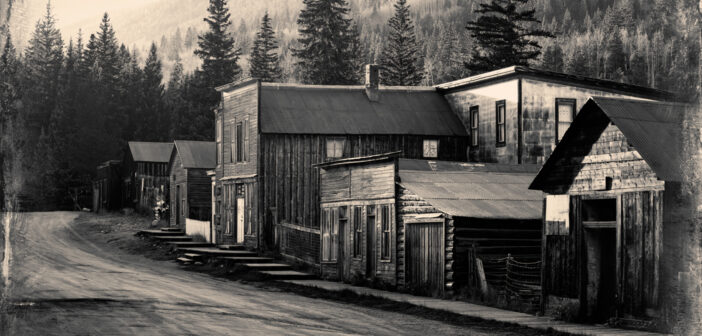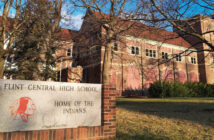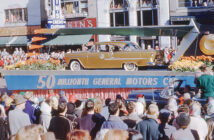When the pioneers first began inhabiting Genesee County starting in the 1830s, settlements began to dot the landscape. As more and more people came to the area to find work in lumber or grain mills, start a business, or find a home, some settlements grew into small, unincorporated villages. MCM presents the lost villages of Genesee County.
Brent (Flushing Township)
In 1836, Thomas L. L. Brent landed in Genesee County and purchased an astounding amount of land (both here and throughout the state). Brent dammed the river and built Flushing Township’s first mill. Early settlers Henry French, David and James Penoyer, James Bailey and others started their pioneer life working on Brent’s farm. So many came to work on the farm that the small village of Brent was established. A man well-liked in his time, Brent had money troubles and was forced to sell his land. Today, the village of Brent is farmland located just south of Mt. Morris Road between Nichols and Seymour Roads. Brent Creek runs through the pioneer’s former property.
Duffield (Gaines Township)
Just south of the railroad tracks, at the intersection of Reid and Duffield Roads in Gaines Township, is the location of the former pioneer village of Duffield. In 1884, just after the village of Gaines was incorporated, a post office was opened in Duffield, which operated until 1927. Today, the lands of Duffield are held by private residences, the Duffield Methodist Church and Westwind Farm.
East Thetford (Thetford Township)
In 1846, industry was churning in Thetford Township. It started with the Gordon & Cook Mill on Butternut Creek then came the Buell, Jacob Smith & Bro., Baird, and Rogers Mills. The Buell Mill was started by the family of (Buell Lake settler) Richard Buell and was the first in the township to be powered by steam. A small village grew up around the Buell Mill which had multiple stores, a school house and blacksmith. Originally named East Thetford, it was more commonly known as Henpeck due to the “forcefulness” of the female villagers. East Thetford was located at the intersection of Vienna and Belsay Roads.
Farrandville (Vienna Township)
When Vienna Township was formed in 1837, northern Genesee County was mostly wilderness. In less than a year, the population skyrocketed. It was a timber rush and one pioneer, Ira T. Farrand, established a settlement. Dubbed Farrandville, it grew to include the Free Methodist Church, and a few shops and dwellings. Today, Farrandville consists of a few homesteads and small businesses located at the intersection of Saginaw and Farrand Roads, approximately one mile north of the City of Clio.
Gibsonville (Grand Blanc Township)
In the County’s earliest days, perhaps the best place for commerce outside of Flint was Gibsonville in Grand Blanc Township. In 1833, a businessman by the name of Charles De Witt Gibson set up shop in the area around Saginaw Street and Dort Highway. There, he opened a general store and sawmill. Soon, more businessmen arrived and, seeing the amount of business Gibson was doing, established stores of their own. In 1848, Gibson opened the Gibson Hotel which became Grand Blanc’s most popular rest stop. The name of the village changed over the years and eventually, the area became more commonly known as Whigville after Gibson’s staunch support of the Whig Party.
Mt. Pleasant (Fenton Township)
In 1840, brothers John and Solomon Cook settled on the north shore of Long Lake (now Lake Fenton). Their goal was to establish a village of their own that would remain well into the future. Dubbed Mount Pleasant, the village was bisected by Shiawassee (now North Long Lake) and Torrey Roads and amounted to nothing more than a school, church and busy mechanic shop. Still, the village gained quite a few settlers and endured into the late 1800s. Today, Lake Fenton Middle School sits on its grounds.
Otterburn (Flint Township)
From 1882 to 1913, a traveler moving from the City of Flint to Swartz Creek would have to pass through a little village called Otterburn. It was so named because otters were often seen in Swartz Creek, a burn (small river). The small place consisted of a train station and post office headed by postmaster Charles F. Shumway. Otterburn was located at the intersection of Miller and Bristol Roads in Swartz Creek.
Pine Run (Vienna Township)
Pine Run missed its chance. Once called Vienna, the Village of Pine Run is the oldest in Vienna Township. Established by Charles McLean in 1833, it grew to include the post office, blacksmith shop, multiple stores, two saloons and two hotels. It thrived in 1855 when Russell Hurd built his grist mill. Josiah Begole established the first school in the township in the confines of the village. Things progressed quickly for Pine Run until in 1861, when a proposal to build a track of the Flint & Pere Marquette railroad through town was rejected. Instead, the railroad was redirected through the present City of Clio, thus sealing Pine Run’s fate. The village was located at the intersection of Saginaw and Vienna Roads.
Podunk (Mundy Township)
In 1834, Revolutionary War veteran, Morgan Baldwin, laid claim to a large parcel of land in Mundy Township. He was soon joined by his friend, George Judson, who purchased land directly adjacent. After Baldwin Road was built through their lands, Judson and Baldwin established a locality called Podunk. The village consisted of a few businesses and mills, but was deserted by the late 1800s. Podunk was located (approximately) at the intersection of Torrey and Baldwin Roads. Now a pioneer museum, Podunk House is the second oldest house still standing in the county and was moved in 1967 to its current location on N. Long Lake Road.
Richfield and Richfield Center (Richfield Township)
The Township of Richfield has long been one of Genesee County’s more forested and undeveloped lands, holding only three now-forgotten villages – two of which existed less than a mile apart. Richfield Center was established in 1837 by Phineas Tucker whose home housed the first post office. In 1938, a school, blacksmith and physician were added. Just north of Richfield Center was the Village of Richfield, established in 1857 by Captain Maxfield. Sometimes called Maxfield, it hugged the Flint River just past the intersection of Stanley Road and M-15. It was mostly residential homes and Maxfield’s Tavern. (Richfield Center was located at the intersection of M-15 and Coldwater Road.) By the early 1900s, both localities were dissolved.
Rogersville (Richfield Township)
The third village to be established in pioneer Richfield Township was Rogersville, established in 1846 by brothers Laban and Alvah Rogers. In 1872, it became a small stop on the railroad and was awarded its own post office. The railroad did not want to invest in a depot in such a small establishment, so the citizens got together and built their own. In 1875, R. D. Rogers built a small hotel while brother, C.W., built and operated a cheese factory. Rogersville existed just north of Mt. Morris Road near Vassar Road.
Whitesburg (Thetford Township)
Located at the current intersection of Vassar and Dodge Roads in Thetford Township, Whitesburg was formed in 1846 around the Gordon & Cook Mill. Platted by Carlos Wilson, it was named Whitesburg in honor of fellow villager, Clark White. The village was home to a blacksmith (Daniel Morse), wagon shop, a school house and a store/entertainment venue built by Abram Cudney, where he played fiddle for travelers through all hours of the night.
Each of the towns and cities we know today grew from these villages and continue to flourish. Some villages, however, disappeared due to extinction of resources and/or lack of infrastructure.








